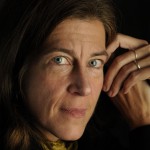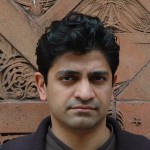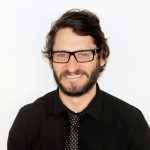Back to INTERSECTIONS 2014 Event Page
 Michelle Addington (Endnote)
Michelle Addington (Endnote)
Hines Professor of Sustainable Architectural Design
School of Architecture
Yale University
Michelle Addington, Hines Professor of Sustainable Architectural Design at the Yale University School of Architecture, is trained as both an architect and an engineer whose teaching and research explore energy systems, advanced materials and new technologies. Originally educated as a nuclear and mechanical engineer, she began her career at NASA/Goddard Space Flight Center, where she developed structural data for composite materials and designed components for unmanned spacecraft. She then spent a decade as a process design and power plant engineer as well as a manufacturing supervisor at DuPont, and, after studying architecture, she became an architectural associate at a firm based in Philadelphia. To further investigate the potential for architecture afforded by new scientific theories in heat transfer and fluid mechanics coupled with emerging technologies, she returned to academia to earn a doctorate in which she researched the discrete control of boundary layer heat transfer using micro-machines. She serves as an advisor on energy and sustainability for many national and international organizations, and her chapters and articles on energy, HVAC, system design, lighting, new technologies and materials have appeared in many books, reference volumes and journals. She co-authored Smart Materials and Technologies for the Architecture and Design Professions and the recently published Emerging Technologies. She joined the faculty of Yale University’s School of Architecture in 2006, and holds a joint appointment at the Yale School of Forestry and Environmental Studies. Prior to teaching at Yale, she taught at Harvard University for ten years and before that at Temple University and Philadelphia University. She received a B.S.M.E from Tulane University, a B.Arch from Temple University, an M.Des.S. and a Dr.Des from Harvard University. She also holds an honorary M.A. from Yale University. In 2009, Architect magazine selected her as one of the country’s top ten faculty in architecture.
The fundamental question underlying her research asks how we can directly, discretely, locally and transiently control phenomena. She has applied her research methods to situations as diverse as determining, at the micro level, why the walls of the Sistine Chapel were even more contaminated after a state of the art HVAC system was installed, to developing, at the macro level, new regional design guidelines for sustainability. Her current projects include the “Intelligent Buildings Project”, a collaborative effort whose objectives include the development of a new metric as well as designing how buildings connect to the smart grid; a new research lab at the “Institute for the Preservation and Conservation of Cultural Heritage” in which she will work on developing micro-environments that travel with art objects and also new LED lighting schemes for museums; and new community energy design strategies for Ecuador and India.
 Mitchell Bring
Mitchell Bring
Adjunct Research Professor
Department of Architecture
University at Buffalo (SUNY)
Mitchell Bring is an Adjunct Research Professor at the Department of Architecture, SUNY Buffalo.
He built his first computers in a garage not far from the Kennedy Space Center, years before Steve Jobs got out of grade school. He went to Architecture School during the time of punched paper card input, but he did get to study with pioneer thinkers – Jim Fitzgibbon and Buckminster Fuller. After living in Japan for several years, he wrote a book about Japanese Design published by McGraw Hill. Some years later as an assistant professor, he started the Georgia Tech Architecture CAD Lab with a grant of 10 seats of AutoCad 2 running on original IBM PCs.
Seduced away from academia by the lure of easy money and fast technology, he started and sold a couple of software companies, only to find out that change in Architecture is slow and the money isn’t so great either. He is still fascinated by the possibility of building buildings that respond to the specifics of an environment, and meet the changing needs and imagination of those who will use it. He will speak briefly about his three years as an “embedded” faculty mentor at Boston Valley Terra Cotta facilitating change and creating better means for the collaborative creation of architecture.
 Robert Campbell
Robert Campbell
Associate Principal
Fisher Dachs Associates Theatre Planning and Design
Robert Campbell is an Associate Principal at Fisher Dachs Associates Theatre Planning and Design and has over 30 years’ experience working in all types of performing arts, from set and lighting design and directing to theatre production management. His expertise at FDA ranges from roles as a project manager, programmer, and planning and design expert. His diverse background in theatre engineering, electrical engineering, acoustics, lighting, architecture and back of house experience
makes him a unique collaborator in the theatre consulting field.
He is currently project manager on several prominent higher education performing arts centers, including the 750-seat Bing Concert Hall at Stanford University, the new Brock University and St. Catherine’s downtown PAC in Niagara, Canada, the Voxman School of Music at University of Iowa, the Hamilton College Theatre, the Marist College Theatre, and University of Wisconsin Madison’s music school. His past educational projects include the Yale School of Drama’s studio theatre, Drew University’s recital hall, and a multipurpose PAC at University of Northern Iowa.
Robert holds an MFA from Yale School of Drama, where he studied theatre engineering and planning, acoustics, and lighting design. He designed productions at both Yale Repertory Theatre and Yale School of Drama, including “The Tempest,” “Shadow of a Gunman,” and “Glengarry Glen Ross.” Robert also has designed lighting for off-off Broadway productions, including “Anything Goes,” “Frankie and Johnny in the Clair de Lune,” “House of Blue Leaves,” “Richard III,” “Threepenny Opera,” and “Shimmer” and assisted Jules Fisher on the touring production of The “Will Rogers Follies.” He serves on the Board of Directors of Gallery Players of Brooklyn, where he directed the company’s productions of “The Odd Couple” and “Night, Mother.”
 Michael K Chen
Michael K Chen
Principal
Michael Chen Architecture (MKCA)
Michael K Chen is principal of Michael Chen Architecture (MKCA), an architecture and design firm based in New York City. MKCA produces both built commissioned work and design research, and operates across a wide range of scales including products, furniture, exhibitions, interiors, and architecture, producing work that is motivated by an enduring fascination with intricacy and the interaction of multiple systems and elements. The office’s work and research have been exhibited, published, and broadcast internationally. MKCA’s ongoing Signal Space project exploring the contemporary and historical relationship between urban form and antennas was featured in the United States Pavilion at the 2013 Venice Biennale where the office exhibited a map of the 12,000+ mobile phone antennas in New York City.
Michael has taught architecture at UC Berkeley, Cornell, Parsons, and Columbia University and is currently a faculty member in the School of Architecture at Pratt Institute in New York City where he teaches seminars and design studios. The work of his studio has also been exhibited and presented internationally, including at the Hong Kong-Shenzhen Biennale of Architecture in 2009, and at numerous academic conferences and events. In 2011 and 2012, the studio was one of twelve contributing to the Culture Now Project an initiative curated by Thom Mayne addressing the design futures of struggling mid-sized American cities.
Michael’s writings on architecture, technology, and urbanism have appeared recently in Bracket [Goes Soft], MAS Context, and Urban Omnibus. He is a graduate of UC Berkeley (AB) and Columbia University (MArch) where he was the recipient of a Kinne traveling fellowship and the Lowenfish award for design excellence. He is the recipient of grants for independent research from the Graham Foundation, Pratt Institute, and the Van Alen Institute, and was the 2003-2004 John Dinkeloo Fellow at the American Academy in Rome.
Michael is a Registered Architect in New York State and a member of the American Institute of Architects.
 Danielle Choi
Danielle Choi
Senior Associate
Michael Van Valkenburgh Associates, Inc.
Danielle’s interest in landscape architecture lies in the complex interactions of natural and urban systems. She contributes her skill in facilitating the dialogue between research, analysis, and design to many MVVA projects, competitions, and writing efforts, including the restoration of a historic Beatrix Farrand landscape on the Princeton University campus, a new framework plan for Amherst College, and, most recently, the design and project management of the Waller Creek project in Austin, Texas. Her research projects have included the documentation of over 20 years of MVVA’s studies on ice as a landscape medium and a case study in post-agricultural ecology in Tomales Bay, CA.
Danielle has taught urban design studio at Columbia University, and she has been a visiting critic at Louisiana State University, Rutgers University, University of Illinois, and Utrecht University. She received a Bachelor of Arts in art history from the University of Chicago, graduating with honors. She earned a Masters in Landscape Architecture from Harvard’s Graduate School of Design and received the Jacob Weidenman graduation award for excellence in design. Prior to joining MVVA in 2009, Danielle practiced landscape architecture in Berlin with TOPOTEK 1.
 Brian Conybeare
Brian Conybeare
Special Advisor
New NY Bridge Project
Brian Conybeare is the Special Advisor to the Governor for the New NY Bridge Project. Brian was appointed by Governor Cuomo in July 2012 to lead the project’s community outreach team and to help ensure the most open and transparent infrastructure project in New York state history. To that end, Brian has held more than 350 meetings with residents, community groups, business associations, elected officials and other stakeholders. Prior to his appointment, Brian spent 16 years as a three-time Emmy Award winning reporter and anchor at News 12 Westchester. Mr. Conybeare received a Bachelor’s Degree in Communications from the University of Michigan and a Master’s Degree in Journalism and Mass Communication from New York University.
 Alex Coulombe
Alex Coulombe
Designer and Consultant
Fisher Dachs Associates Theatre Planning and Design
Alex Coulombe is a designer and consultant at Fisher Dachs Associates Theatre Planning and Design. He received his B. Arch in 2010 from Syracuse University where his award-winning thesis, Scopic Operations in Military Theatre, proposed transforming Fort Jay on Governors Island into a multi-stage performance venue with virtualized components. Alex holds a strong interest in design visualization and currently pursues a workflow utilizing Unity software in tandem with the Oculus Rift. Recently, his article “Transvancement” was published in the Young Architect Forum “Connection” magazine. He is also a board game designer and playwright: “Rum Run” won the 2011 Game Crafter Mash-Up Contest, and his latest play, “Dystopiapiapia” will be premiering at the NYC Thespis Theatre Festival in July. He enjoys interdisciplinary collaboration. Check out his work at www.alexcoulombe.com.
 Michael Fritz
Michael Fritz
Master Sculptor and Industrial Designer
Boston Valley Terra Cotta
Michael Fritz is Master Sculptor and Industrial Designer at Boston Valley Terra Cotta. He earned his Bachelors of Fine Arts Degree from the Cleveland Institute of Art and his MFA from the State University of New York at Buffalo. His classical arts training combined with fifteen years of experience in sculptural restoration have afforded him extensive knowledge in nearly every facet of the restoration effort. In collaboration with the University at Buffalo School of Architecture and Planning, he is directing new technologies in site documentation, digital modeling, and CNC towards both centuries old methodologies in terra cotta restoration, as well as contemporary collaborations in architectural ceramics and design.
 Martha Gross
Martha Gross
Senior Consultant
Arup
Martha Gross, a senior consultant at Arup, has spent the past 2½ years helping convert the new Tappan Zee Bridge from two dimensions into three. Following a civil-engineering degree with an honors thesis in history, she studied bridge design as a Fulbright scholar in Stuttgart, Germany, and started her building career in the heavy-construction industry. This led to curiosity about how we pay for what we build, resulting in an MBA and PhD in infrastructure finance and delivery. Now as the owner’s deputy commercial director for the $3 billion Tappan Zee project, she continues to find that the most intriguing questions arise at the crossroads of multiple fields.
 Sheila Kennedy (Keynote)
Sheila Kennedy (Keynote)
Founding Principal
KVA MATx
Sheila Kennedy is an American architect, innovator and educator. She is a Professor of the Practice of Architecture at MIT and a founding Principal of KVA Matx, an interdisciplinary design practice that works at the intersection of architecture, urbanism and the design of soft infrastructure for emerging public needs. Designated as one of Fast Company’s emerging Masters of Design, Kennedy is described as an “insightful and original thinker who is designing new ways of working, learning, leading and innovating”.
Kennedy directs KVA’s material research division MATx which works with business leaders, cultural institutions, NGO’s and public agencies to create and deliver next generation resilient products and public infrastructure for networked cities and urbanizing regions. MATx has created designs and commercialization pathways for Dupont, Siemens, Osram, Herman Miller, 3M, The North Face, the United States Department of Energy, Volkswagen “Think Blue” and the Electrical Utility Company of Portugal in Brazil.
Recent work at KVA Matx includes the RiverFIRST Minneapolis Riverfront Initiative, America’s largest sustainable urban riverfront development, the new East 34th St Ferry Terminal in Manhattan, the Soft House carbon neutral work/live residential development at the International Building Exhibition in Hamburg, Germany. KVA Matx has been recognized by AIA National Design Excellence Awards, Progressive Architecture Awards, Industrial Design Excellence Awards, the 2013 Digitizer Fabrication Award, the Chicago Athenaeum’s Good Design Award, the Green Council’s National Building Innovation Award and the Public Work Award of the National Endowment for the Arts. The KVA MATx Portable Light Project, a non-profit global initiative to create energy harvesting textiles in the developing world has been recognized with the 2012 and 2009 Energy Globe Awards, a 2009 US Congressional Award, and a 2008 Tech Museum Award for technology that benefits humanity.
Kennedy’s design work has been exhibited at MoMA, the Cooper Hewitt National Design Museum, the International Rotterdam Biennal, the Vitra Design Museum, and the TED conference in California. Kennedy’s work has been widely published in journals of architecture and design culture. She has been invited to share her work at the United Nations in New York, on National Public Radio, BBC World News, CBS News, The Discovery Channel, CNN Principal Voices, Wired, Elle Magazine, The Economist, and The Wall Street Journal.
 Omar Khan
Omar Khan
Associate Professor & Chair
Department of Architecture
University at Buffalo (SUNY)
Omar Khan is an Associate Professor and Chair of the Department of Architecture at the University at Buffalo. His work spans the disciplines of architecture, digital craft and interaction design. His research investigates the role of pervasive media and computing for designing responsive architecture and environments. This has followed different strategies including augmenting environments with sensing and actuating technologies, rethinking material substrates and assemblies and theorizing on ways to develop mutualist relationships between people and their built environment. He is a co-editor of the Situated Technologies Pamphlet Series and a director at the Center for Architecture and Situated Technologies at the University at Buffalo. He is also co-principal at the design firm Liminal Projects. He completed his post-professional studies at the Massachusetts Institute of Technology in Design and Computation, where he worked in the Aesthetics and Computation Group (acg) at the MIT Media Lab, and his professional studies at Cornell University.
 Nick Leahy
Nick Leahy
Principal
Perkins Eastman
A Principal at Perkins Eastman with 30 years of experience, Nick Leahy AIA, LEED AP manages, directs and leads design for the firm on projects across a number of industry sectors. His work ranges from large-scale urban design projects to civic buildings, museums, and cultural centers. Leahy’s design approach is characterized by a critical balance of place, program, and craft. Key to this methodology is the investigation of each site’s relationship to its environment, history, and its intended use. Recent projects include the award-winning design of the TKTS Booth in Times Square, the winning international design competition entry for the shanghai World Expo Public Events Center, and the renovation and design for the Lower East Side Tenement Museum’s new Visitors Center.
 Michael Ludvik
Michael Ludvik
Structural Engineer and Principal
M.Ludvik Engineering Consulting Engineers
Michael is a structural engineer and principal of M.Ludvik Engineering consulting engineers. He is a structural and façade engineer focusing on glass and special structures. His portfolio features structural glass work in the US and globally, including the TKTS Booth at Times Square and the indoor skydiving wind glass wind tunnels in Dubai, and the Coach Store in Tokyo. Architect collaborators include OMA, Grimshaw, and Diller Scofidio + Renfro. His process is rooted in respect for both shop floor practicalities as well as human response. An on-going theme is the adaptation of industrial technologies for a post-industrial world.
 Michael Martello
Michael Martello
Program Lead
HDR
Michael is a registered professional engineer with 6+ years of experience in bridge design. His experience ranges from vehicular to rail-transit structures including cast-in-place post-tensioned box girders, pre-stressed precast concrete girders, multi-girder/multi-span steel girder bridges, and gusset plat load ratings for steel truss bridges. He offers a high level of expertise in the field of finite element modeling, specifically for bridge structures.
Currently Michael is the global analysis task leader for the approach spans of the Tappan Zee Hudson River Crossing project. Over the ast year in this role he was in charge of furnishing a full analytical model of the 3-mile twin structure from abutment ot abutment to perform a seismic analysis of the Crossing. The Global Model, constructed using the RM Bridge v8i structural analysis package, will also serves as the foundation for a 3D design model which will be connected to an as-built database for use in maintaining and operating the bridge over its 100 year lifetime.
Michael received his Bachelor of Science degree in civil engineering from Manhattan College prior to his arrival at HDR in 2008, and went on to receive his Master of Science degree in civil engineering from Manhattan College in 2011.
 Alessandro Ronfini
Alessandro Ronfini
Designer
Bjarke Ingels Group
Alessandro Ronfini is a designer at BIG NYC and a registered architect in Italy. In the past 3 years he has been working on the design and construction of 625W57, a large residential project in Manhattan, focusing in particular on its peculiar double curved facade. During his career he has been involved in different projects and competitions worldwide, always focusing his research on the rationalization of complex structures and subsequent controlled detailing in order to make them buildable. His work has been published and exhibited in Europe and Asia.
 Peter Schmidt
Peter Schmidt
Head of Digital Design and Development
Boston Valley Terra Cotta
Peter Schmidt is the Head of Digital Design and Development at Boston Valley Terra Cotta. He completed his Master of Architecture thesis in May 2014 at the University at Buffalo School of Architecture and Planning. His Master’s thesis investigates the changing relationship between architects and manufacturers through the use of digital tools. Collaborating with craftsman at Boston Valley Terra Cotta, he designed and built a 4-axis wire cutter that customizes extruded terracotta for facades. It will provide a new platform for collaboration between architect and craftsmen that can truly take advantage of CAD/CAM technology. His thesis was awarded the ARCC/King Student Medal for excellence in architectural research.
 Michael Stellato
Michael Stellato
Director of Special Projects
David Shuldiner, Inc.
Michael Stellato is the Director of Special Projects at David Shuldiner, Inc., one of the oldest glass, glazing and architectural metal firms in NYC. He has been involved in such notable projects as TKTS in Times Square, IAC Atrium and interiors, Gucci Flagship at Trump Tower, and Sea Cliffs Exhibit at Coney Island Aquarium, always working to find practical solutions to complex jobs. Michael is a long-time advocate of proactive, deliberate interaction between the design team and project contractors and brings more than forty years of experience in the industry.
 Scott Streeb
Scott Streeb
Senior Associate
Michael Van Valkenburgh Associates, Inc.
Scott is a Senior Associate and key member of the MVVA creative team. He has led the schematic and conceptual design phases of many projects, including the Pier 54 Performance Pier at Hudson River Park in New York City, the Coney Island Amphitheater and North Grant Park in Chicago. He is uniquely skilled at translating program and concepts into plan and physical form, and the spatial distribution of program as part of landscape design.
Scott is an avid rock climber and has been a proponent of including rock climbing programming in MVVA park designs. He has contributed to the design and construction documentation of Jacob K. Javits Plaza in New York City, numerous Brooklyn Bridge Park projects including the Pier One Hotel and Condos, Pier 6, Pier 3 and Pier 4 Uplands, the DEP conversion site, and the Squibb Bridge landscape. Scott has also served as lead designer and project manager for many smaller scale garden projects including Jardin Matisse in Quebec, the Willow Street Garden in Brooklyn, and the Koi Project in Baton Rouge, LA.
Scott received a Bachelor of Landscape Architecture from Colorado State University, where he was awarded the esteemed ASLA Honor Award. Scott has been a guest lecturer at CSU. He joined MVVA in 2007.
 Alex Worden
Alex Worden
Designer
Enclos Façade Engineering



